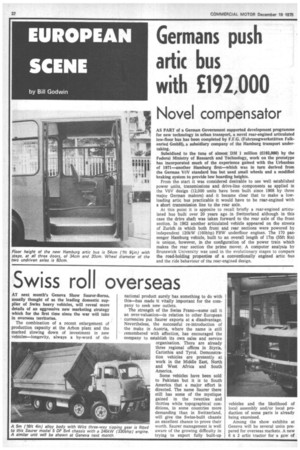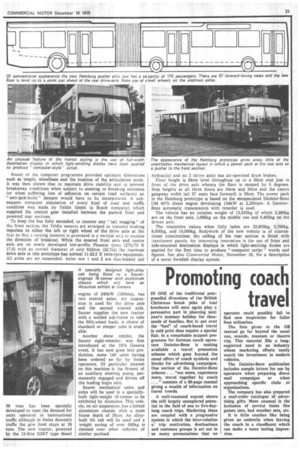Germans push artic bus with £192,000
Page 24

Page 25

If you've noticed an error in this article please click here to report it so we can fix it.
Novel compensator
AS PART of a German Government supported development programme for new technology in urban transport, a novel rear-engined articulated low-floor bus has been completed by F.F.G. (Fahrzeugwerkstlitten Falkenried GmbH), a subsidiary company of the Hamburg transport undertaking.
Subsidised to the tune of almost DM I million (E192,000) by the Federal Ministry of Research and Technology, work on the prototype has incorporated much of the experience gained with the Urbanbus of 1971—another Hamburg first—which was in turn derived from the German VEN standard bus but used small wheels and a modified braking system to provide low boarding heights.
From the start it was considered desirable to use well established power units, transmissions and drive-line components as applied in the VoV design (12,000 units have been built since 1968 by three major German makers) and it became clear that to make a lowloading artic bus practicable it would have to be rear-engined with a short transmission line to the rear axle.
At this point it is apposite to recall briefly a rear-engined articulated bus bunt over 20 years ago in Switzerland although in this case the drive shaft was taken forward to the rear axle of the front section. In 1962 another articulated vehicle appeared on the streets of Zurich in which both front and rear sections were powered by independent 120kW (160hhp) FBW underfloor engines. The 170 passenger Hamburg vehicle, built to an overall length of 17m (55ft 9in) is unique, however, in the configuration of the power train which makes the rear section the prime mover. A computer analysis by Brunswick University was used in the evolutionary stages •to compare the road-holding properties of a conventionally engined artic bus and the ride behaviour of the rear-engined design. Result of the computer programme provided optimum dimensions such as length, wheelbase and the location of the articulation point. It was then shown that to maintain drive stability and to prevent breakaway conditions when subject to steering or breaking extremes . (or when suffering loss of adhesion on certain road surfaces) an " anti-jack-knife " damper would have to be incorporated. A subsequent computer simulation of every kind of road and traffic condition was made by Teldix Gmbh (a Bosch company) which supplied the control gear installed between the pushed front and powered rear sections.
To keep the bus fully extended, to counter any " tail wagging" of the front section, the Teldix sensors are arranged to transmit braking impulses to either the left or right wheel of the drive axle at the rear so that a turning moment is generated in a veitical axis to counter the direction of breakout. While the steered front axle and centre axle are on newly developed low-profile Phoenix tyres (275/70 R 17.5) with an overall diameter of only 832mm (32.7in) the rearmost drive axle in this prototype has normal 11-22.5 X twin-tyre equipment. All axles are air suspended. Axles nos 1 and 2 are disc-braked (air
hydraulic) and no 3 (drive axle) has air-operated drum brakes.
Floor height is 54cm level throughout up to a 20cm step just in front of the drive axle whence the floor is ramped by 5 degrees. Step heights at all three doors are 34cm and 20cm and the centre gangway width (all 57 seats face forward) is 56cm. The power pack in the Hamburg prototype is based on the encapsulated Daimler-Benz OM 407h diesel engine developing 154kW at 2,200rprn. A DaimlerBenz automatic transmission with retarder is used.
The vehicle has an unladen weight of 12.530kg of which 3,380kg are on the front axle, 2,695kg on the middle one and 6,455kg on the driven axle.
The respective values when fully laden are 23,800kg, 5,700kg, 8,000kg, and 10,000kg. Bodywork of the new vehicle is of conventional construction; th ceiling of the rear section is fitted with ranslucent panels. An interesting innovation is the use of front and side-mounted destination displays in which light-emitting diodes are applied for the first time to produce " computer script" words and figures. See also Commercial Motor, November 28, for a description of a novel Swedish display system.












































































